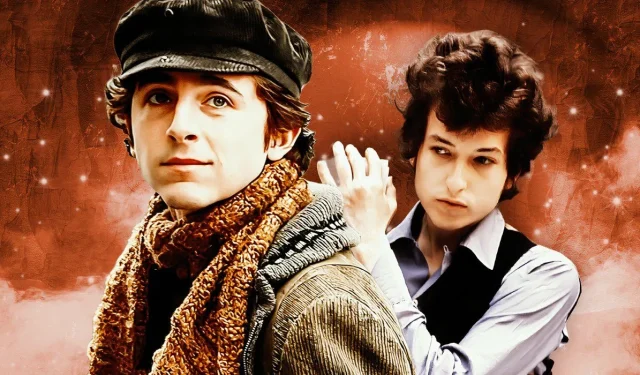
WARNING: SPOILERS ahead for A Complete Unknown.
Overview of A Complete Unknown
After taking nearly ten years off from touring, Bob Dylan’s remarkable musical journey continued, highlighted in the new film A Complete Unknown. Released on Christmas Day 2024, this biopic features Timothée Chalamet portraying the iconic folk singer-songwriter. The film also stars Elle Fanning, Edward Norton, Monica Barbaro, Dan Fogler, and Boyd Holbrook as Johnny Cash. Although it chronicles Dylan’s rise to fame, A Complete Unknown introduces various fictional elements that deviate from Bob Dylan’s actual life story.
Directed by James Mangold, known for his critically acclaimed works like Ford v. Ferrari and Logan, the film has received positive acclaim, boasting a 79% score on Rotten Tomatoes and an outstanding 95% audience rating. It is a strong contender for multiple awards, including three Golden Globe nominations: Best Motion Picture – Drama, Best Actor for Chalamet, and Best Supporting Actor for Norton. The narrative primarily focuses on Dylan’s formative years in New York, his legendary ascent aided by figure Pete Seeger, and his romantic entanglements with Sylvie Russo and Joan Baez.
Currently, A Complete Unknown is showing in theaters nationwide.
Bob Dylan’s Motorcycle Accident: A Life-Changing Event
The Incident on July 29, 1966

On July 29, 1966, Bob Dylan was involved in a motorcycle accident that effectively ended his touring career for nearly a decade. This incident took on new meaning following the film’s climax where Dylan speeds away from the Newport Folk Festival in 1965. Just a year later, Dylan crashed his motorcycle near Woodstock, New York, shortly after completing his 1966 World Tour. The specifics of the accident remain somewhat shrouded in mystery, especially since he refused hospitalization. However, it is known that he sustained injuries, including broken vertebrae in his neck.
As reported by Motorcyclist, “No hospital records have ever been sealed relating to the incident, and no one remembers an ambulance carting off the Tambourine Man.” Allegations from eyewitnesses suggest the accident was minor, involving a low-speed fall that merely required a visit to a doctor. In his 2004 autobiography Chronicles, Dylan remarked, “I had been in a motorcycle accident and I’d been hurt, but I recovered. Truth was that I wanted to get out of the rat race.”
Bob Dylan’s Return to Touring in the 1970s
Reuniting with The Band in 1974

Despite his hiatus from live performances after the accident, Dylan remained active in music, producing several albums during this period, including the acclaimed Highway 61 Revisited and Blonde on Blonde. Albums such as John Wesley Harding (1967), Nashville Skyline (1969), Self-Portrait (1970), and New Morning (1970) further reinforced his influence. Finally, in 1974, Dylan returned to live performances through a tour with The Band, comprising 40 shows running from January 3 to February 14.
Dylan’s Spiritual Awakening and Gospel Era
A Three-Album Christian Music Journey

Following his return to stage performance during the Rolling Thunder Revue Tour (1975-76) and a subsequent world tour in 1978, Dylan experienced a spiritual shift that led him to explore Christianity and gospel music. He released three gospel-oriented albums: Street-Legal (1978), Slow Train Coming (1979), and Saved (1980), featuring notable tracks such as “When He Returns”and “I Believe in You.”This aspect of his artistry was highlighted during his Gospel Tour, although it received mixed reviews from both fans and critics. Eventually, in the 1980s, Dylan transitioned back to rock music with albums like Infidels (1983) and Empire Burlesque (1985).
Recognition in the Rock and Roll Hall of Fame
Induction by Bruce Springsteen

In 1988, after establishing himself as a multifaceted artist transitioning from a folk hero to a rock legend, Bob Dylan was inducted into the Rock and Roll Hall of Fame. During the ceremony, Bruce Springsteen fondly recounted his early experiences with Dylan’s music, recalling, “I knew I was listening to the toughest voice I’d ever heard.” The Hall noted, “Bob Dylan is one of the greatest songwriters of all time, a gifted wordsmith with a political conscience and a poet-like acumen for meter and language.”
The Never Ending Tour: A Legendary Journey
Finally Ending in 2019

Dylan began the 1980s by pursuing gospel music and, by 1987, collaborated with the Grateful Dead. The inception of the Never Ending Tour occurred in 1988, coinciding with his Hall of Fame induction. This relentless touring schedule continued until 2019, paused primarily due to the global COVID-19 pandemic. His tour was supposed to recommence in 2020, starting in Tokyo and concluding in Rochester, but ultimately was cancelled. As of 2024, Dylan resumed touring with the Bob Dylan’s Rough and Rowdy Ways Worldwide Tour, which took place in March across several southern states.
Bob Dylan’s Marital History
Marriages and Divorces

At 83 years old, Bob Dylan has experienced two marriages and divorces but is not currently married. His romantic relationships, notably with Sylvie Russo (played by Fanning in A Complete Unknown) and his tumultuous affair with Joan Baez (played by Barbaro), did not lead to marriage. The film also fictionalizes a British romantic interest named Becka, diverging from Dylan’s actual history.
Dylan’s first marriage was to Sara Dylan (née Shirley Noznisky), whom he wed quietly in 1965 while she was expecting their first child, Jesse. Together, they had three more children: Anna, Sam, and Jakob, before their divorce in 1977. In 1986, he married Carolyn Dennis, with whom he had a daughter, Desiree Dennis-Dylan, before their divorce in 1992. His brief relationship with Sally Kirkland in the early 1970s is notably absent from the current film narrative.




Leave a Reply